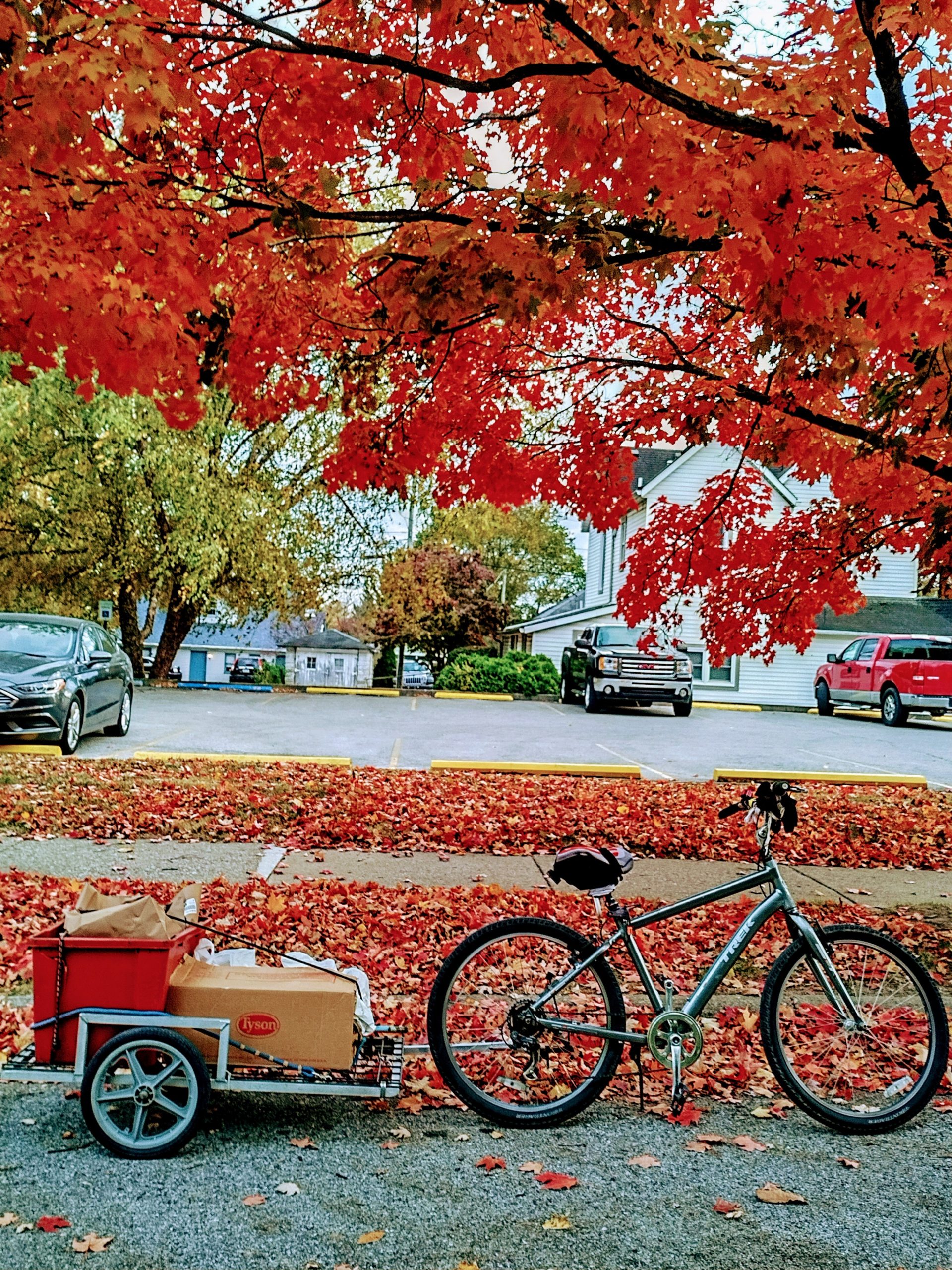Podcast: Play in new window | Download (Duration: 30:32 — 42.0MB)
Subscribe: RSS
| Hello and welcome to Eco-Report. For WFHB, I’m Julianna Dailey. And I’m Cynthia Roberts. In this edition of Eco Report, Environmental Correspondent Zyro Roze delves into Bloomington’s designation as a Gold Level Bicycle Friendly Community by the League of American Bicyclists. |
|
And now for your environmental reports: The following article is about the future of the Hoosier National Forest: Log and burn, or leave alone? Indiana residents fight the US Forest Service over the future of Hoosier National Forest. The mighty, valuable oak is at the center of conflict between federal officials and logging opponents over how to manage mature forests in an era of climate change. The following story comes from Inside Climate News and presents arguments on both sides of this issue. In two of the largest projects the U.S. Forest Service has ever undertaken in the historic Hoosier National Forest, the agency plans to log more than 9,000 acres, conduct prescribed burns on another 28,000 and build more than 27 miles of roads. The “Houston South” and “Buffalo Springs” proposals have engendered fierce local opposition, not only from horse riders and hikers but chambers of commerce, and elected officials, Republicans and Democrats alike. The contest taking shape in southern Indiana is part of a larger battle now being waged over the future of the National Forests, the nation’s greatest reservoirs of forest carbon, in a changing climate. President Joe Biden has sought to protect mature and old-growth forests, but clearly his Forest Service is resisting the concept of preserving older forests as a strategic reserve of carbon, which some climate scientists have advocated. Last month, the Biden administration announced a plan for new regulations to enhance “climate resilience” in those forests. It was a follow-up to a first-of-its-kind inventory ordered by Biden that showed mature and old-growth forests make up 60 percent, or 112 million acres, of the forests managed by the Forest Service and Bureau of Land Management. But the Forest Service has more than 20 projects underway like the Hoosier plans that include logging or burning in 370,000 acres of those mature and old-growth forests, according to the Climate Forests Campaign, a coalition of environmental groups. The Forest Service, which is taking public comments through June 20 on what its new climate rules should look like, argues “restoration” and “vegetation management” activities, like the Buffalo Springs and Houston South projects proposed in Indiana, may be better in the long run from a climate change perspective. The Forest Service says that with predicted changes in climate, especially hotter, drier summers in the Midwest, Hoosier National Forest is more likely to experience wildfire and therefore they must plan appropriately to have a fire-resilient forest. More than half of the stands in the Hoosier are 80 years old or older, and there has been a sharp decline in establishment of new ones, the Forest Service said in its assessment of the carbon impact of the Buffalo Springs portion of its Hoosier Proposal. If the Forest continues on this aging trajectory, more stands will reach a slower growth stage in coming years, potentially causing the rate of carbon accumulation to decline, the assessment said. The plan is to make way for new oak habitat by clear-cutting 1,100 acres and otherwise culling mature trees the Forest Service says are less resilient and beneficial to the ecosystem, including maple, beech and pine. —Norm Holy |
| And now, continuing with the article on the Hoosier National Forest:
But Richard Birdsey, who spent 40 years with the Forest Service before his retirement as a distinguished scientist in 2016, says, in effect, that the agency’s climate science in this instance is wrong. Such a fall-off in carbon absorption can take hundreds of years to unfold as trees die and decay. Middle-aged forests of the eastern United States would continue to absorb and store carbon over the next two crucial decades for staving off the climate crisis—if they are allowed to stand, he said. Recent scientific papers Birdsey has co-authored show how protection of large-diameter older trees can help further biodiversity and other forest resilience goals, and how more robust forest conservation policy could help mitigate climate change. If you harvest an older forest, it creates what’s called a carbon debt, Birdsey said. You’ve removed a lot of stored carbon, and in order to replenish that we’re looking at decades, if not centuries. Having worked in the eastern U.S. for the Forest Service, Birdsey is familiar with oak restoration like the agency proposes in the Hoosier. He said the agency may have reason to pursue such projects, but should not try to justify them on the basis of climate protection. There might be other reasons—let’s say for wildlife—for removing some of the trees and allowing some different species to grow, Birdsey said. But that has nothing to do with climate. And in a case like that, you just have to accept that it is not going to be good for climate. Both Native Americans and early white settlers burned the forest repeatedly, usually to clear the land for agriculture. The territory that became Indiana, which was 90 percent forest-covered prior to the start of the 19th century, had only 4 percent forest cover left by 1900, according to a 2018 report by the Purdue-led Indiana Climate Change Impacts Assessment. Thick-barked oaks survived the fires, and thrived in the open spaces—even on north-facing slopes with less direct sunlight. Indiana’s forests now cover about 20 percent of the state, but most of that woodland remains in private hands. The Forest Service began buying abandoned land here and in other Eastern states during the Great Depression. The Hoosier is now filled with stands of non-native pines planted 50 to 90 years ago through federally funded efforts like the New Deal-era Civilian Conservation Corps to stop rampant erosion on bare, abandoned farmland. But the Forest Service says the pine plantations are less suitable habitat for wildlife and biodiversity than oak, and should be removed. Also targeted are shade-tolerant species like American beech and sugar maple that have been regenerating instead of oaks and hickories. Prescribed fire—in most cases, preceded by logging mature trees—reduces forest density and removes the competition. The projects will improve the sustainability of the oak-hickory ecosystem and move the landscape toward historic conditions, the Forest Service said in its statement of need for the Buffalo Springs project. The Forest Service said it is looking to mimic Native American settlements in Indiana that date back to 12,000 BC. Evidence suggests extensive use of fire by Native peoples for centuries and people have been on this landscape since nearly the last ice age, therefore our native plant and animal life evolved with fire and are adapted or tolerant of it at low intensities, which is what our prescribed fires are, the Forest Service said. Now, with impacts of climate change already evident, critics say the Forest Service is seeking to recreate an era that was anything but a healthy one for Indiana’s forests. They’re trying to restore the forest back to the most degraded baseline that ever existed there, said Jeff Stant, executive director of the Indiana Forest Alliance. They always use the word ‘historic,’ so that the public will think they’re trying to go back to the way nature really was. But much of the dominance of oak-hickory forest in southern Indiana is an artifact of heavy rural settlement in the 1800s. —Norm Holy |
| The fires in Nova Scotia and Quebec were a surprise. What happened? Nova Scotia’s capital Halifax received just 3 inches of rain between March and May, roughly a third of the average, according to The Weather Network meteorologist Michael Carter. A scorching late May heatwave pushed temperatures in Halifax to 33C (91.4 F), about 10 degrees Celsius above normal for this time of year. The wildfires are believed to have been caused either by lightning, as in the case of Quebec, or accidentally by human activity.
Ellen Whitman, a research scientist with the Canadian Forest Service, said there is also speculation that trees felled during Hurricane Fiona, which hit Atlantic Canada in September 2022, or killed by an infestation of forest pests may be providing more fuel than usual for wildfires, but that theory requires further investigation. There is every reason to expect that fires in these Provinces will become more frequent. —Norm Holy |
| The number of Monarch butterflies hibernating in Mexican forests decreased last winter to about 5.5 acres. This was about 20 percent lower than the winter of 2021—2022, but not greatly different than populations seen over the past decade. Frost and “extreme temperatures” in the United States may have played a role in the butterfly’s decline during the most recent winter season, said Humberto Peña, director of Mexico’s nature reserves.
Illegal logging has been a major threat to the pine and fir forests where the butterflies gather in clumps to keep warm. But experts said that this year, more than half the tree loss was due to removal of dead or sick trees affected by fires, storms or pests. A lack of rain had plunged trees into hydric stress, making them more vulnerable to diseases, pests and fires. The Western population, overwintering in California, had dropped from 10 million butterflies in the 1980s to just 1,914 monarch butterflies in 2021. Since then, California has seen a rebound with 330,000 monarch butterflies recorded in 2023. —Norm Holy |

And now, we turn to Zyro Roze as he asks Hank Duncan, Bloomington’s Bicycle and Pedestrian Coordinator, about the aspects of becoming a Bicycle Friendly Community, the City’s metrics and sources of data, room for improvement and the special recognition of the 7-Line bike lane by People for Bikes.
|
| For Eco Report, I’m Julianna Dailey. And I’m Cynthia Roberts. Are you looking for a way to make a difference on environmental issues?
Here at EcoReport we are currently looking for reporters, engineers, and segment producers. Our goal is to report facts on how we’re all affected by global climate disruption and the ongoing assaults on our air, land and water. We also celebrate ecologists, tree huggers, soil builders and an assortment of champions who actively protect and restore our natural world, particularly those who are active in south central Indiana. All levels of experience and all ages are welcome, and we provide the training you’ll need. WFHB also offers internships. |
| To volunteer for Eco-Report, give us a call at (812) 323-1200, or e-mail us at: [email protected]. |
|
And now for some upcoming events: Learn all about mountain biking at the GO BikeIN Mountain Bike Workshop on Saturday, June 17th, from 10 am to 1 pm at Brown County State Park. This beginner class will teach you valuable skills and help you get comfortable on the bike. You will end your training with a ride on one of Brown County’s renowned mountain bike trails. Register at [email protected]. |
| The Indiana Forest Alliance is hosting a public hike in Yellowwood State Forest Back Country to view some of the most bio-diverse forest in the state on Saturday, June 17th, from 10 am to 1 pm. Meet at the Yellowwood Back Country access off of Possum Trot Road in Morgantown. |
| Enjoy a Summer Solstice Morning Stroll at Spring Mill State Park on Wednesday, June 21st, from 9 to 10:30 am. Stroll on Trail 4 to bring in the longest day of the year. Meet at the Donaldson Cave parking lot. This is a 2-mile, rugged hike. |
| A Trail Care Day at Green’s Bluff in Owen County is coming up on Saturday, June 24th, from 9 am to Noon. Hike the Raccoon Woods Trail and help keep this scenic trail in tip top shape. |
| Take a Garden Insects: Friends and Foes class at the Butler Park Community Gardens on Saturday, June 24th, from 5 to 6:30 pm. Discover the insects that call your garden home. Find out which ones are friends and/or foes. To register, go to bloomington.IN.gov/parks. |
| And that wraps up our show for this week.
EcoReport is brought to you in part by MPI Solar, a Bloomington business specializing in solar hot water, solar electricity and solar hot air systems. MPI Solar designs and installs solar power generation systems that encourage independence and individual responsibility. Found locally at 812-334-4003 and on the Web at MPIsolarenergy.com. |
| This week’s headlines were written by Norm Holy. Today’s news feature was produced by Zyro Roze and edited by Noelle Herhusky-Schneider. Julianna Dailey assembled the script which was edited by Zyro Roze. Julianna Dailey compiled our events calendar. Kade Young and Noelle Herhusky-Schneider produced today’s show. Branden Blewett was our engineer. |
| For WFHB, I’m Julianna Dailey. And I am Cynthia Roberts. And this is EcoReport. |
 WFHB Bloomington Community Radio
WFHB Bloomington Community Radio



